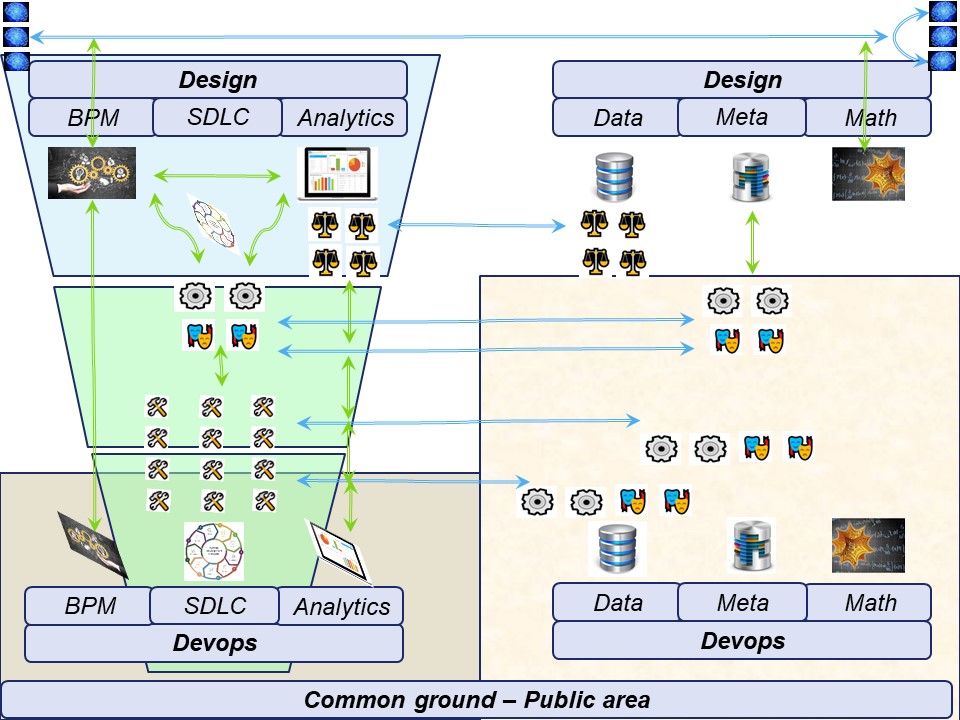RO-1.1 Contents
⚙ RO-1.1.1 Looking forward - paths by seeing directions
A reference frame in mediation innovation

When the image link fails,
🔰 click
here.
There is a revert to main topic in a shifting frame.
Contexts:
◎ C-Shape mediation communication
↖ C-Serve technology, models
↗ I-C6isr organisational control
↙ infotypes
↘ techflows
Fractal focus in mediation innovation
The cosmos is full of systems and we are not good in understanding what is going on.
In a ever more complex and fast changing world we are searching for more certainties and predictabilities were we would better off in understanding the choices in uncertainties and unpredictability's.
Combining:
- Systems Thinking, decisions, ViSM (Viable Systems Model) good regulator
- Lean as the instantiation of identification systems
- The Zachman 6*6 reference frame principles
- Information processing, the third wave
- Value Stream (VaSM) Pull-Push cycle
- Improvement cycles : PDCA DMAIC SIAR OODA
- Risks and uncertainties for decisions in the now near and far future, VUCA BANI
The additional challenge with all complexities is that this is full of dualities - dichotomies.
⚙ RO-1.1.2 Local content
⚖ RO-1.1.3 Guide reading this page
The quest for methodlogies and practices
This page is about a mindset framework for undertanding and managing complex systems.
The type of complex systems that is focussed on are the ones were humans are part of the systems and build the systems they are part of.
When a holistic approach for organisational missions and organisational improvements is wanted, starting at the technology pillar is what is commonly done.
Knowing what is going on on the shop-floor (Gemba).
Working into an approach for optimized systems, there is a gap in knowledge and tools.
👁 💡 The proposal to solve those gaps is
"Jabes". It is About:
- ⚙ Document & communicate Knowledge (resources, capabilities, portfolio, opportunities).
- 📚 Defining boundaries in context in knowledge domains of disciplines.
- 🎭 In a knowledge domain of as discipline a standardize metadata structure.
- ⚖ Maturity evaluation of quality Document & communicate Knowledge.
Seeing "Jabes" as a system supporting systems the question is what system is driving Jabes?
The system driving Jabes must have similarities to the one that is driving it.
👁 💡
ZARF (Zachman-Augmented Reference Frame) is a streamlined upgrade to the classic Zachman matrix.
It turns a static grid into a practical, multidimensional map that guides choices, enforces clear boundaries, and adds a sense of time, so teams move methodically from idea to reality
Business intelligence - Artificial intelligence
The world of BI and Analytics is a challenging one.
It is not the long-used methodology of producing administrative reports.
A lot needs to get solved, it is about information for shaping change:
The issue is that is technology driven situation, where it should be:
- ⚙ Operational Lean processing, design thinking
- 📚 Doing the right things, organisation & public.
- 🎭 Help in underpinning decisions boardroom usage.
- ⚖ Being in control, being compliant in missions.
Dashboarding reporting for closed loops used in good-regulators are approaches in the attempts solving those in systems.
❗ ⚠ The fractalness in systems make it unclear who the stakeholder for some dashboarding really is.
The technology drive by the market is hiding the question for who and what in the why in variety and fractals of systems.
A recurring parabal for methodlogies and practices
An often used similarity is going to the life at and on ships.
The simplification is that is a clear boundary for the internal and external systems of the ship.
There are nice clear three vertical rows:
- The executives deciding over what to happen on the ship and the direction it should go.
- Space for the product - service whether it are passengers or cargo.
How this is manged needing dedicated staff.
- The engines for the structure (data centre) out of sight below visibility.
Dedicated staff operating informing and advising on decisions.
This can be set in a perspective of: Strategy, Tactical, Operational.
Another perspective could be: Far future, near future and the now.
For each of them there are however dualities and dichotomies.
There are nice clear three horizontal columns:
- The structure for the goal and purpose what the ship does (BPM)
- Managing the structure for the technology the engines (SDLC)
- Getting the information for informed decisisons (Analytics)
Interacting with the external systems in some controlled alignment:
- Information resources for getting better decisions (Data).
- Improving the knowledge by what is known (Meta).
e.g. de product - service handling in cargo and passengers
- Changing the knowledge in what is not already known (Math).
e.g. new product -service opportunities or a complete different ship.

In a figure,
see right side
The allegory for using a ship goes on into how to mange that.
Your business is a boat navigating the river of waste. (S.Angad, 2025)
What you see above water are symptoms.
What's hidden below are the real problems.
| what's visible | real problems |
| Machine downtime | Untrained workforce |
| Quality defects | Forecast inaccuracy |
| Long changeovers | Poor communication |
| Schedule delays | Outdated processes |
Most leaders focus on what's visible, but these are just rocks breaking the surface.
The real problems are underwater.
Here's what I've learned after years of helping manufacturers:
👉🏾 You can't steer around every rock.
👉🏾 You have to lower the water level.
When you reduce the waste in your system, problems that were hidden suddenly become visible.
That's uncomfortable. But it's necessary.
Most improvement efforts fail because they treat symptoms.
Real improvement lowers the water level.
| treat symptoms | Real improvement |
| Hire more inspectors for quality issues | Train people to prevent quality issues |
| Add buffer inventory for supply problems | Fix forecasting to reduce inventory needs |
| Work overtime for capacity constraints | Improve flow to eliminate capacity constraints |
| Buy faster machines for throughput gaps | Standardize work to reduce variation |
The goal isn't to avoid problems.
The goal is to see them clearly so you can solve them permanently.
Your biggest competitive advantage isn't having fewer problems.
It's solving problems faster than your competition.
Lower the water level. Expose the rocks. Remove them one by one.
⚒ RO-1.1.4 Progress
done and currently working on:
- 2025 week 50
- The old page completely consolidated, started emptied
The topics that are unique on this page
👉🏾 Explaining the patterns that are repeating seen in this.
- Connecting components for the systems as a whole,
- There must be an effective good regulator for the system to be viable.
- Searching the relations for systems to their universe.
- Motiviations and distraction seen in repeating patterns.
👉🏾 use cases using the patterns for Zarf and by Zarf.
- More practical examples that help in applying Zarf
- Use cases are not fixed but can vary in time
- Adaption to uses cases when there are clearly recognised.
Highly related in the domain context for information processing are:
- C-Shape the abstracted approach for shaping, the related predecessor.
- r-c6isr command and control practical an abstracted approach, in what to shape.
- c-shape the practice follower of the predecessor.


 When the image link fails, 🔰 click here.
When the image link fails, 🔰 click here. 




 . . . . . . . . . . . . . . . . . . . . . . . . . . . . . . . . . . . . . . . . . . . . . . . . . . . . . . . . . . . . . . . . . . . . . . . . . . . . . . . . . .
. . . . . . . . . . . . . . . . . . . . . . . . . . . . . . . . . . . . . . . . . . . . . . . . . . . . . . . . . . . . . . . . . . . . . . . . . . . . . . . . . .